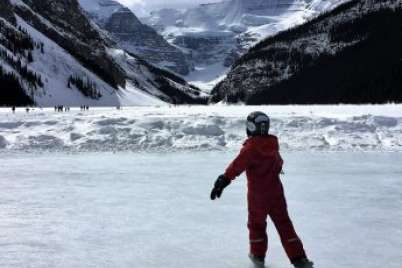
How to get into speed skating in Canada (at any age)
A few years ago, while leaving the dressing room after a sweaty hockey practice, my now 13-year-old paused at the fingerprint-smudged glass to watch a speed-skating practice.
Youngsters not much taller than mini-sticks teetered around centre ice, and tweens flashed by—faces set with concentration.
“That,” said my own tween, “looks cool.”
Skating’s chilly roots trace back over 1,000 years to the canals of the Netherlands, when it was used as a means of transportation across the frozen waterways. When the sport of speed skating came to be, it eventually spread to Canada, where the country’s first recorded race took place in 1854 along the St. Lawrence River, between Montreal and Quebec City.
From those early days, the sport has grown in popularity and performance, and it’s no surprise that Canadians (who are used to both the cold and skating) have done well in international competitions. Since the country’s first Olympic speed-skating medals were won at Lake Placid in 1932, the sport has brought Canada 70 Olympic medals. An impressive feat considering that short track speed skating has only been in the Olympics since 1992.
What exactly is speed skating?
Two primary disciplines make up the sport: short track, called short-track speed skating, and long track, which is commonly referred to as just speed skating.
Short-track speed skating takes place indoors on regular arena-sized ice, while international competitions are on a 111-metre oval track. The compact turns can be tricky, so rink boards are covered in protective mats to cushion the skaters. In short track, events are “mass starts” with skaters racing all together on a single track with the first person across the line winning. If you’ve ever seen short track in person or on television, you’ve witnessed the excitement and probably held your breath as the athletes leaned and raced around the tight track.
Long-track speed skating requires a much larger 400-metre oval, and has a pair of racers change lanes every lap so that they both cover the same distance. Skaters in both short and long track race counter-clockwise, with only left-hand turns, though most skaters train in both directions to balance muscular development and improve coordination. Though skaters can start in either short or long track, short track is more readily available in Canada.
When to start
With Speed Skating Canada’s Long Term Athlete Development (LTAD) model, youngsters can improve their skating and become confident in their movements and skills through play and games in FUNdamentals. Learning to speed skate is not only limited to children! Clubs often offer both kids and adult lessons, making it a sport that can be enjoyed by the whole family.
The Edmonton Speed Skating Association (ESSA) welcomes participants of all ages. “The best age for a child to start speed skating is whatever age they are right now,” says Chris Padbury, the association’s president.
Padbury notes that for those looking to try speed skating, it’s not necessary to have prior skating experience and most clubs are ready and equipped to teach children with very limited skating experience.
“At the [ESSA] we only expect that kids can get themselves upright without assistance after falling. Over several years, children progress from learning basic skating skills, to more specific speed skating technique, to advanced topics like racing strategy.”
“Speed skating is truly a sport for all ages and abilities,” agrees Mary Frances Carter, executive director of Ontario Speed Skating. “We welcome skaters who are transitioning from figure skating, hockey, ringette, or recreational skating. We have seen skaters reach the national high-performance racing pathway who started skating when they were three years old, as well as those who transitioned to speed skating in their teens.”
“It really is never too late to start speed skating, even if you never plan to compete in a race. It is a great ‘for life’ sport that can be done by almost anyone.”
-Chris Padbury, Edmonton Speed Skating Association president
Benefits for skaters and families
Besides being a fun way to stay active and exercise, speed skating helps develop agility, reflexes, balance, and coordination. “Speed skating is great for training the cardiovascular system, and building muscle strength and endurance—after all, our whole sport is done in a squat position!” says Carter.
With team-based leagues, there’s also a strong social aspect that allows kids to hone important skills such as teamwork and communication, and it’s not uncommon for friendships to form between members of different clubs.
“Speed skating is the kind of sport where your competitors are also your training partners and friends off the ice,” says Carter. “Physical activity is an important factor in supporting mental health as well, and speed skating is a sport where the whole family can be active together.”
What you’ll need
Speed skating equipment is often available to rent from clubs and outfitting a new skater may not be as expensive as anticipated. “It is a bit of a niche sport, and such sports are often assumed to be expensive,” says Padbury. “However, most of the required equipment can be ‘borrowed’ from other sports, like soccer shin guards and hockey neck guards.
The costliest equipment is skates, but clubs often have pairs to borrow or rent for the season and can be sized up as feet grow. Beginners can start off in the sport with hockey or figure skates. “It really is an amazingly easy sport to get involved in with very low barriers to entry,” adds Padbury.
Want to give it a try?
Find a list of provincial and territorial clubs here.
Photo credit: Stephen Maunder





